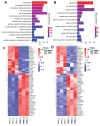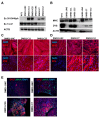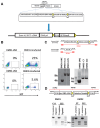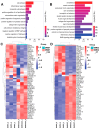A Novel CRISPR-Cas9 Strategy to Target DYSTROPHIN Mutations Downstream of Exon 44 in Patient-Specific DMD iPSCs
- PMID: 38891104
- PMCID: PMC11171783
- DOI: 10.3390/cells13110972
A Novel CRISPR-Cas9 Strategy to Target DYSTROPHIN Mutations Downstream of Exon 44 in Patient-Specific DMD iPSCs
Abstract
Mutations in the DMD gene cause fatal Duchenne Muscular Dystrophy (DMD). An attractive therapeutic approach is autologous cell transplantation utilizing myogenic progenitors derived from induced pluripotent stem cells (iPSCs). Given that a significant number of DMD mutations occur between exons 45 and 55, we developed a gene knock-in approach to correct any mutations downstream of exon 44. We applied this approach to two DMD patient-specific iPSC lines carrying mutations in exons 45 and 51 and confirmed mini-DYSTROPHIN (mini-DYS) protein expression in corrected myotubes by western blot and immunofluorescence staining. Transplantation of gene-edited DMD iPSC-derived myogenic progenitors into NSG/mdx4Cv mice produced donor-derived myofibers, as shown by the dual expression of human DYSTROPHIN and LAMIN A/C. These findings further provide proof-of-concept for the use of programmable nucleases for the development of autologous iPSC-based therapy for muscular dystrophies.
Keywords: CRISPR-Cas9; DMD; dystrophin; gene editing; patient-specific iPS cells; transplantation.
Conflict of interest statement
R.C.R.P. is cofounder and holds equity in Myogenica. All other authors have no competing financial interests.
Figures





Similar articles
-
Restoration of Dystrophin Protein Expression by Exon Skipping Utilizing CRISPR-Cas9 in Myoblasts Derived from DMD Patient iPS Cells.Methods Mol Biol. 2018;1828:191-217. doi: 10.1007/978-1-4939-8651-4_12. Methods Mol Biol. 2018. PMID: 30171543
-
Precise correction of the dystrophin gene in duchenne muscular dystrophy patient induced pluripotent stem cells by TALEN and CRISPR-Cas9.Stem Cell Reports. 2015 Jan 13;4(1):143-154. doi: 10.1016/j.stemcr.2014.10.013. Epub 2014 Nov 26. Stem Cell Reports. 2015. PMID: 25434822 Free PMC article.
-
CRISPR/Cas9 editing of directly reprogrammed myogenic progenitors restores dystrophin expression in a mouse model of muscular dystrophy.Stem Cell Reports. 2022 Feb 8;17(2):321-336. doi: 10.1016/j.stemcr.2021.12.003. Epub 2022 Jan 6. Stem Cell Reports. 2022. PMID: 34995499 Free PMC article.
-
Molecular correction of Duchenne muscular dystrophy by splice modulation and gene editing.RNA Biol. 2021 Jul;18(7):1048-1062. doi: 10.1080/15476286.2021.1874161. Epub 2021 Jan 20. RNA Biol. 2021. PMID: 33472516 Free PMC article. Review.
-
Restoration of dystrophin expression and correction of Duchenne muscular dystrophy by genome editing.Expert Opin Biol Ther. 2021 Aug;21(8):1049-1061. doi: 10.1080/14712598.2021.1872539. Epub 2021 Jan 25. Expert Opin Biol Ther. 2021. PMID: 33401973 Review.
Cited by
-
Correction of exon 2, exon 2-9 and exons 8-9 duplications in DMD patient myogenic cells by a single CRISPR/Cas9 system.Sci Rep. 2024 Sep 11;14(1):21238. doi: 10.1038/s41598-024-70075-5. Sci Rep. 2024. PMID: 39261505 Free PMC article.
-
Advanced delivery systems for gene editing: A comprehensive review from the GenE-HumDi COST Action Working Group.Mol Ther Nucleic Acids. 2025 Jan 17;36(1):102457. doi: 10.1016/j.omtn.2025.102457. eCollection 2025 Mar 11. Mol Ther Nucleic Acids. 2025. PMID: 39991472 Free PMC article. Review.
-
Transcriptional adaptation upregulates utrophin in Duchenne muscular dystrophy.Nature. 2025 Mar;639(8054):493-502. doi: 10.1038/s41586-024-08539-x. Epub 2025 Feb 12. Nature. 2025. PMID: 39939773 Free PMC article.
-
Induced Pluripotent (iPSC) and Mesenchymal (MSC) Stem Cells for In Vitro Disease Modeling and Regenerative Medicine.Int J Mol Sci. 2025 Jun 11;26(12):5617. doi: 10.3390/ijms26125617. Int J Mol Sci. 2025. PMID: 40565081 Free PMC article. Review.
-
Advances in Duchenne Muscular Dystrophy: Diagnostic Techniques and Dystrophin Domain Insights.Int J Mol Sci. 2025 Apr 10;26(8):3579. doi: 10.3390/ijms26083579. Int J Mol Sci. 2025. PMID: 40332074 Free PMC article. Review.
References
-
- Mias-Lucquin D., Dos Santos Morais R., Chéron A., Lagarrigue M., Winder S.J., Chenuel T., Pérez J., Appavou M.-S., Martel A., Alviset G., et al. How the central domain of dystrophin acts to bridge F-actin to sarcolemmal lipids. J. Struct. Biol. 2020;209:107411. doi: 10.1016/j.jsb.2019.107411. - DOI - PubMed
Publication types
MeSH terms
Substances
Grants and funding
LinkOut - more resources
Full Text Sources

